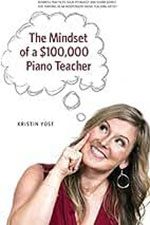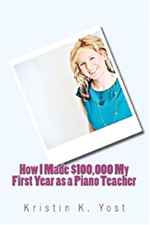Resource Gems:
Financial Calculator Tools for the Studio Music Teacher
Timothy Stephenson
MTNA Business Digest, Volume 4, Issue 2
January 2025
Finances, taxes and rates, oh my! For many teachers, the financial aspects of running a private studio can be daunting, but we are lucky to live in an age when so many essential, yet simple, tools are available with just the click of a button.
Many of us launched an independent studio with confidence about our teaching skills, but with less comfort managing the financial side of things. If you are anything like me, you felt a sense of dread or guilt each time you increased lesson rates. There is so much to unpack here about knowing your value as an educator, but some basic knowledge about things like inflation can help every studio teacher feel more confident about their financial decisions.
As our studios grow, it is wise to invest in software like QuickBooks or hire an accountant. For basic financial planning, it is helpful to equip ourselves with readily available tools. Below are just a handful of simple calculator tools that can help teachers plan everything from lesson rates to retirement needs.
CPI Inflation Calculator
Important elements to consider when assessing studio rates and general revenue needs are inflation rates and the Consumer Price Index (CPI). For those in the United States, the U.S Bureau of Labor Statistics the go-to resource and provides more information about CPI than most teachers could possibly need. If it has been a while since you changed your rates, the above calculator is a useful place to start—try entering your lesson rate with the month/year you most recently changed it and compare it to this month. The buying power is the rate you should charge today to keep up with inflation. This can be an eye-opening exercise!
If you are in the habit of adjusting your rates every year, this 12-month Inflation Rate Chart is a useful reference in helping assess in real time how inflation is affecting your income compared to one year ago.
Rate Increase Risk Calculator
Courtesy of Music Studio Startup, this easy-to-use calculator helps remove anxieties around raising lesson rates by assessing how many students a teacher can afford to lose based on their rates and the number of students in the studio. There are many useful tools on the resources page at Music Studio Startup and you can become a Hub member (starting at $7) to access an extended library of resources, including this handy Studio Growth Tracker!
Numbers to Know in Your Music Studio Business
Another excellent resource from Music Studio Startup is this studio metrics calculator that helps assess studio performance and financial health. This calculator considers net profit, profit margin, fixed costs and cash reserves and runway to give users an idea how their studios are doing financially. To learn more, check out Andrea Miller’s Top 5 article (LINK) in this issue!
Pricing Calculator for Musicians
For a one-stop-shop, Musician and Company offers business tools for self-employed musicians, including the above calculator. For a reasonable price, this calculator will help studio teachers determine their materials and labor costs, overhead expenses, tax estimates and more to set and maintain a profitable lesson rate. Musician and Company offers several other financial templates specific to musicians that can be purchased on the site.
Student Loan Simulator
Many of us must factor student (and other) loans into our financial plans. The Federal Student Aid office includes a useful tool for calculating the length, total cost, interest rates and more based on several adjustable factors. The loan simulators are not exclusive to student loans, and it can be helpful to run through various scenarios to determine which makes the most sense for your particular revenue, priorities, and life circumstances.
Retirement Savings Calculator
While everyday life keeps us plenty occupied, we should also be thinking on some level about what our lives will look like when we retire. This involves thoughtful financial planning that is very personal and specific. The above calculator considers several factors, including age, inflation rates, current savings, types of accounts and more. Even if you do not have all the details now, it is a useful place to start to understand what you will need when you reach that season of life. If you are living in the United States, don’t forget to consult the government’s social security resources to estimate your future social security benefits. It is also important to understand the limits and restrictions that exist for retirement saving plans such as traditional and Roth IRAs.
Looking for a good read?


Davis Dorrough, NCTM
How I Made $100,000 My First Year as a Piano Teacher and The Mindset of a $100,000 Piano Teacher by Kristin Yost
Kristin Yost has long been a trailblazer in the world of independent piano teaching, offering innovative strategies for teachers seeking not only financial success but also personal fulfillment in their careers.
I first came across Yost around 2011, when she published How I Made $100,000 My First Year as a Piano Teacher. I heard even more buzz among piano teachers after she gave a standout MTNA session in 2014 on the same compelling topic. Her approach to making six figures as a piano teacher especially resonated with those of us who were fresh graduates entering the profession, eager to create sustainable, profitable studios. I incorporated many of her strategies as I established my first independent music studio and owe her a great deal for helping inspire the vision that shaped its success.
Her second book, The Mindset of a $100,000 Piano Teacher (2017), shifts focus to the mentality needed for long-term success, drawing on over a decade of experience running her music school, Centre for Musical Minds. This review will explore both books in tandem, highlighting how they complement each other while offering key takeaways from Kristin Yost’s approach to building a successful piano teaching career.
How I Made $100,000 My First Year as a Piano Teacher (2011)
Kristin Yost’s How I Made $100,000 My First Year as a Piano Teacher offers a detailed roadmap for aspiring music studio owners, drawing from her own transition from graduate student to business owner. The book opens with Yost’s inspiring personal story, showing readers that with the right strategy and mindset, they, too, can turn their passion for music and teaching into a thriving career.
Yost covers the nuts and bolts of starting and managing a music teaching studio, beginning with essential marketing strategies like creating a logo, professional photos, a polished website and business cards. Her focus on branding is particularly helpful, emphasizing the need for a teaching philosophy, biography and resume. She also highlights the importance of location, offering advice on conducting demographic research to find the best spot for a studio.
One of the book’s defining features is Yost’s approach to teaching, which focuses on aligning instruction with the goals and preferences of students and parents. She advocates a modern approach to music education, incorporating popular music, chord charts, improvisation and technology through apps like GarageBand. In addition to these innovative methods, her students perform in recitals, study music theory and participate in festivals, creating a well-rounded and dynamic learning experience.
Yost also provides practical advice on studio management, covering topics such as using studio management software, managing bookkeeping and organizing schedules. On the financial side, she discusses analyzing market rates, her preference for maintaining full pricing without discounts and the ease and efficiency of running a credit card-only business. Her step-by-step guide to creating a business plan is invaluable, especially for those new to running a business. Additionally, Yost offers a clear formula for calculating what it takes to reach six figures.
Though written in 2011, and with some details that might feel a bit dated, the book remains an invaluable resource for teachers—whether they’re just starting out or aiming to elevate their current business practices. It remains a great complement to more current online resources, offering timeless advice on professionalism, teaching philosophy, and dreaming big. One of Yost’s most enduring recommendations is finding a mentor who has successfully walked the same path.
How I Made $100,000 My First Year as a Piano Teacher is an excellent resource, especially for new studio owners, that blends practical advice with an inspiring success story.
The Mindset of a $100,000 Piano Teacher (2017)
In The Mindset of a $100,000 Piano Teacher, Kristin Yost revisits her teaching journey a decade after establishing her music studio, offering fresh insights that reflect her evolving philosophy and outlook on both teaching and business. While her earlier book, How I Made $100,000 My First Year as a Piano Teacher, focused on the tangible steps to financial success, this follow-up shifts away from monetary goals, focusing instead on the pursuit of personal fulfillment, growth and long-term happiness in one’s career.
Yost emphasizes the importance of being genuinely invested in students’ growth, highlighting the deeper rewards of teaching: “I’m genuinely interested in my students, and I enjoy helping them because I love to see growth.” The book is less about the practical mechanics of running a studio and more about cultivating a mindset for success, offering research-backed strategies for achieving peak performance in both life and business. It’s a thoughtful exploration of self-improvement, mindfulness and maintaining a sense of balance in a demanding field.
Drawing on her own experience, Yost delves into topics like deep work, mastering one’s craft, and focusing on students’ strengths rather than weaknesses. She also touches on embracing change and fostering creativity as a business owner. Concepts like failing forward, imposter syndrome and personal growth feature heavily, making this book a rich resource for teachers who want more than just financial success—they want to thrive.
Though more focused on personal philosophy, the book also expands on practical advice introduced in Yost’s first work. She provides deeper insights into creating a professional identity, leveraging social media, and building a strong value proposition. Tips on improving a variety of processes are included, emphasizing that success in business relies as much on organization and preparation as it does on vision and mindset.
Ultimately, The Mindset of a $100,000 Piano Teacher serves as a guide for music studio owners ready to move beyond the financial aspect of business ownership and focus on what it truly means to flourish.
Final Thoughts
Whichever book you choose to dive into first, both have made a significant impact on the music teaching community, challenging the notion that teachers should settle for anything but the very best when it comes to standards for financial success and fulfillment. Together, they offer a powerful blend of practical strategies and mindset shifts, empowering teachers to build rewarding careers while staying true to their passion for music and education.
Ask Us Anything!
Welcome to this new segment, designed to meet your needs! This issue’s question comes from a recent graduate who started an independent studio in Indiana: “I expect to earn less than $10,000 from my home studio this year, which is less than the standard deduction. Do I need to file a tax return?”
Question:“I expect to earn less than $10,000 from my home studio this year, which is less than the standard deduction. Do I need to file a tax return?”
Answer: Great question, especially for teachers who are new to being sole proprietors. It’s important to start with a reminder that all income is to be reported to the IRS. For your home studio, you will report your studio income on Schedule C, and then also report the expenses that your studio business incurred. Subtracting the expenses from the income will give you the net profit (or loss) for your business.
The net profit number will then be reported on Form 1040 (for most filers), along with other income you might have earned from other jobs or gigs. You will then total up all income sources and deduct a standard deduction (set by the IRS, based on your filing status of single, married couple filing jointly, head of household, etc.) or calculate itemized deductions. Many filers use the standard deduction, especially early in their careers. However, if you have significant eligible expenses, such as a home office, medical costs or charitable contributions, itemizing your deductions might result in greater tax savings.
Subtracting the standard deduction from your total income will yield your taxable income or the amount on which your federal income tax will be calculated.
Using your example, let’s assume your studio net profit is $10,000. After calculating this net profit on Schedule C, you’ll then report this income on Form 1040. The 2024 standard deduction for single filers is $14,600. So, your taxable income will be $10,000 minus $14,600, which is less than zero. For a taxable income of zero or less, you will not owe any federal income tax. But you still filed a tax return to report your studio income.
There are several factors besides income level that influence when/why you need to file a tax return.
If you made more than $400 in net profit as a self-employed teacher (sole proprietor), you will need to file a tax return. You may not owe any federal income tax, but you will owe self-employment FICA taxes, which fund Medicare and Social Security programs.
If you had a second job that hired you as an employee (and issued you a W-2 at the end of the year), then the employer likely withheld taxes from your paychecks. Or you made estimated tax payments for the year. Or you had any of your overpayment for last year applied to this year’s estimated tax. To receive a refund of these taxes, you will need to file a tax return.
If you received income from a gig that issued you a Form 1099-NEC or Form-MISC, you should file a tax return to report this income. Many music teachers receive this type of income from freelance performing, adjudicating or other gigs. These employers may or may not have withheld taxes. You are still required to report all income and are responsible for any income tax and self-employment tax that may be due.
Keep in mind state tax requirements may vary and you may be required to file a state tax return even if you are not liable for federal income tax. Check your state’s tax filing thresholds and guidelines.
There are other (less common) reasons to file a tax return. Please seek advice from a professional tax advisor or CPA regarding the specifics of your situation and read more here.
One final reminder: Accurate and detailed record-keeping is essential when filing taxes as a sole proprietor. Be sure to keep receipts, invoices, and documentation of expenses to substantiate any deductions claimed on Schedule C.
Information provided in this article is for educational purposes only.
Do you have a question for the MTNA Business Network teachers? Ask us anything! Submit questions or provide feedback.

Tim Stephenson
is a pianist, teacher and administrator on staff at the Indianapolis Symphony Orchestra and on faculty at Pacific Piano School. Tim is currently a doctoral candidate at IU’s Jacobs School of Music.

Davis Dorrough, NCTM, MM, is an author, teacher and piano editor at Alfred Music. He is co-author of the Easy Piano Lead Sheets and Chord Charts series, created to help students master essential contemporary music skills